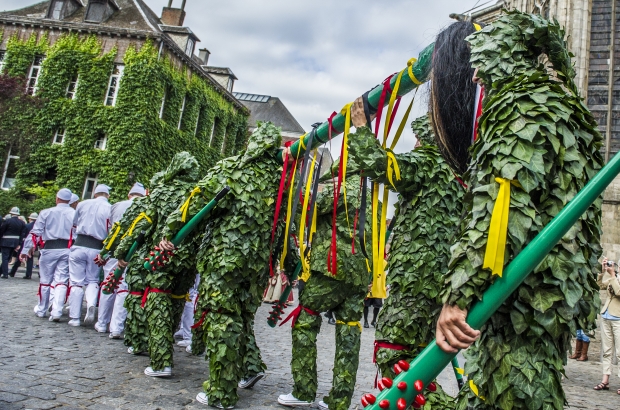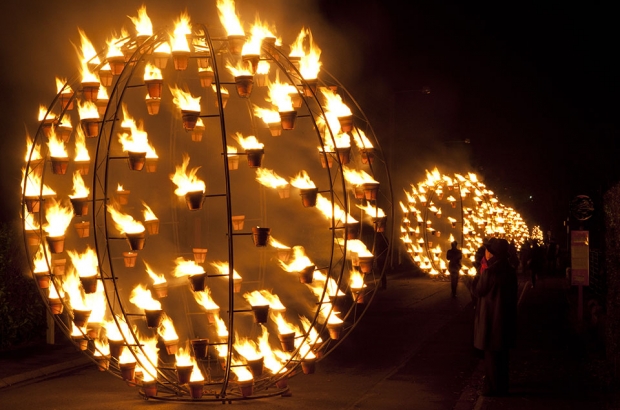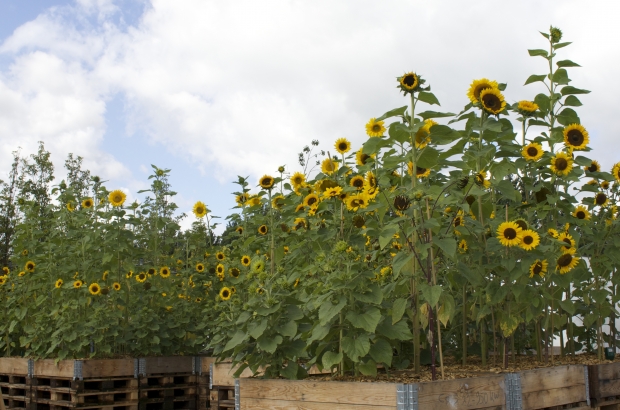- Daily & Weekly newsletters
- Buy & download The Bulletin
- Comment on our articles
Mons 2015: a year-long cultural extravaganza
When Mons is crowned European Capital of Culture on January 24, celebratory fireworks will light up the winter sky. In launching a cultural programme of 1,000 events, it represents the largest arts celebration in Wallonia.
Mons 2015 is a once-in-a-generation opportunity for the former industrial city and region to shine on the international stage. In choosing the slogan ‘Where technology meets culture’, the city is seeking to further reverse the economic decline that blighted the area in the latter half of the 20th century. Since 2000, the former coalmining capital has succeeded in attracting high-tech industries, including global media giant Google, earning it the title of Wallonia’s Silicon Valley.
The culture accolade is not only about creating new jobs; it is also designed to swell coffers by boosting tourism. Little known outside Belgium and northern France, Mons currently draws 200,000 visitors a year. In 2015 it expects this to leap to 2 million before settling down to 500,000 a year. Underpinning the urban renaissance are a series of major heritage renovations and, in a double architectural coup, the construction of two iconic buildings. While a congress centre by New York architects Daniel Libeskind Studio is due to be inaugurated, the soaring Santiago Calatrava-designed railway station will not be unveiled until 2017. These projects are an integral part of the plan to transform Mons into a modern international city, cultural beacon, economic hub and all-round better place to live.
The city’s three Unesco-classified sites and events are also coming under the spotlight: its belfry, Neolithic flint mines at nearby Spiennes, and the annual folklore festival Ducasse. Known locally as Doudou, this battle between St George and the dragon is a riotous and colourful attraction that dates from the Middle Ages. Over a long weekend in June, the ritual draws thousands of spectators.
Crucial to the lasting legacy of Mons 2015 is a cluster of new museums. Most of the important cultural sites are already open to the public, while some will be inaugurated in the spring. The majority are the result of a rich architectural legacy based on the town’s military past: 19th-century remains of barracks, mess halls, stables and riding arenas. A converted pump house is undergoing another metamorphosis and is due to open as Mons Memorial Museum. Recording the city’s military past, including important World War One and Two activity, it is set to make a major contribution to Belgium’s battlefield tourism.
Yves Vasseur is now director of the Mons 2015 Foundation and is understandably proud of the city’s transformation. “Ten years ago you could never imagine that Mons would become a European Capital of Culture,” he says. “It was in a very bad situation socio-economically, and there was no real political input to change the mood until Elio Di Rupo became mayor in 2000 and decided to change his city.”
He paints a sad picture of life in Mons 30 years ago. “After the closure of coalmines in the region we had the highest level of unemployment and there was little future for youngsters. After studying in the city, there were few work possibilities.” It was an innovative move, says Vasseur, to attract new technologies to the area. “After the arrival of the Google data centre, many small start-ups have come to the region. There are now 100 new enterprises with more than 1,000 employees, many of them in the audiovisual, hi-tech industry.”
The technology and culture theme runs through the programme; firstly, with digital techniques bringing performance, visual arts, music and architecture into one creative cluster. “Secondly,” Vasseur says, “most major artists use virtual pictures, settings and sounds that echo our theme. And finally, many innovative companies, particularly those involved in social affairs and gaming, will invest in culture within the context of 2015.
The programme has been constructed around a couple of flagship exhibitions, “to attract people from further away”, he adds. Vincent Van Gogh is the big draw and the foundation is working with Flemish and Dutch cultural organisations to stage the show. Vasseur’s message to visitors is simple: “Mons deserves 2015. It needed waking up. Now discover a city that you don’t know.”
Programme
The opening ceremony on January 24 has an illumination theme with 18,000 silver ponchos being handed out to convert crowds into a magic, mobile mirror ball. Candles and fireworks will also set the city alight. Divided into four seasons, the programme opens with The Dazzling (January 24 to March 31). In the Mons Superstar exhibition (Anciens Abbatoirs, January 24-April 12) discover the men and women who have shaped the city and region. The show may be a learning experience, but the interactive approach transforms it into a treasure hunt. Another trail, The Phrase, features poetry in the streets. Wander through the compact city and read sentences in capital letters painted on walls, stirring the imagination and recalling Mons’s literary past. The Maison Folie is naturally the setting for Ailleurs en folie/Home and Away, in which cities around the world are showcased. A revolving series of artist curators each present their city: Montreal, Milan, Beijing, London, Casablanca, Melbourne, Tokyo and fellow 2015 culture capital Pilsen, in the Czech Republic. The event kicks off with Lille, the birthplace of the Maison Folie when the French city held the title in 2004. The curator is Roubaix artist Fanny Bouyagui (January 28-February 1).
Highlight - Van Gogh in the Borinage. The Birth of an Artist
January 25 to May 17
The celebrated Dutch Impressionist worked as a pastor in Hainaut’s coal basin, the Borinage, from 1878 to 1880. It turned out to be a significant period in his life as it was here that he made the life-changing decision to become an artist. This exhibition, featuring artworks loaned by three major museums, shows how his time in the area influenced his work. Although the exhibition includes rarely seen drawings and important letters written in 1879, don’t expect to find sun-dappled canvases. Visitors can also visit his renovated home in the nearby village of Cuesmes. Vincente Minnelli’s movie Lust for Life, starring Kirk Douglas, was partially filmed in the region in 1965. Specially restored, a world premiere will be accompanied by a documentary on the shooting of the film. Yves Vasseur says he hopes Douglas’s son Michael will attend. “It was an important film for his father and one of the first times a Hollywood movie was filmed outside Los Angeles,” he says. In honour of the artist’s sojourn in the area, a sunflower motif runs through the programme of Mons 2015.
www.bam.mons.be
Where to stay, where to eat
It’s easy to walk around cobblestoned Mons. The small city is built on a hill (hence the name), and the skyline is dominated by the Unesco-classified belfry and the imposing gothic collegiate church of Sainte-Waudru. Climb up to the belfry park for a panoramic view of the city and surrounding countryside. The focal point of the city is its medieval main square with sumptuous 13th-century town hall.
Dream Hotel The four-star hotel in the heart of the historic city is housed in a dramatic 19th-century neo-gothic former church. Ecclesiastical features remain; modern additions are a spa complex, modern restaurant and bar.
Hotel St James Three-star 18th-century contemporary-styled hotel on edge of city-centre, plus four apartments.
Auberge de Jeunesse de Mons Youth hostel in modern building ideally situated at foot of belfry and close to main square
Le Bistro de Jean-Phi As a finalist in popular French TV show Top Chef in 2013, Jean-Philippe Watteyne is a culinary celebrity in his home town. This is his second address opposite existing restaurant iCook, due to move to larger premises. The bistro remains for downtown diners with seasonal and creative dishes, while local beers on tap include a trio of blondes: Chouffe, Chimay and the Mons 2015 official brew Car d’Or, named after the golden carriage that features in the annual Doudou celebration.
Ô Bar’ Hik Annabelle Jonnaert shares her passion for the grape in this wine bar/lounge. An extensive menu of wines and champagne hail from France, Portugal, Spain, Italy and the new world. A selection of wines by the glass changes weekly. Platters of charcuterie and local artisan cheese accompany as well as tapas. Also on sale: artisan jams, oils and spices and gourmet gift baskets. Happy hour, Thursday 19.30-20.30, plus monthly Sunday literary aperitifs.
The Mons 2015 Foundation has compiled a list of restaurants promoting gastronomy in the region. Take advantage of a loyalty card for a free aperitif in many. Options in Mons include: Villaine fille, mauvais garçon, La Table du Boucher, Le 44, La 5ème Saison, Le Bistroniquement Belge, L’Envers, Le Marchal. Outside Mons: Michelin-starred L’Impératif (Maisières), L’Ubiquité (Grand-Hornu), Le Bercha (Binche).





















